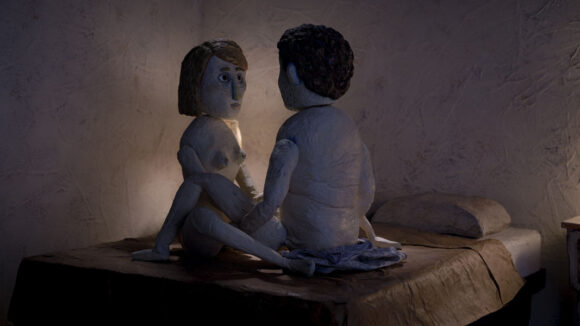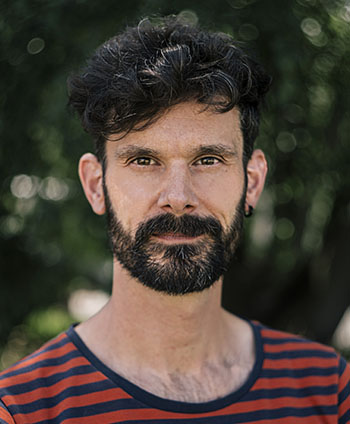

2025 Oscars Short Film Contenders: ‘Duck’ Director Elie Chapuis
Cartoon Brew is putting the spotlight on animated short films that have qualified for the 2025 Oscars.
In this installment, we’re looking at Duck (Canard) from Swiss filmmaker Elie Chapuis. The short earned its Oscars qualification by winning the best animation film award at Warsaw Film Festival and best short animation at In the Palace International Short Film Festival.
In a small isolated farm located in an undefined countryside, Vladimir and Olga raise ducks. They hope for a child, but this expectation soon turns into a nightmare in this eerie short where dreams and reality collide through stop-motion animation. The film is a Belgian-Swiss co-production by Beast Animation and Helium Films.
Cartoon Brew: In Duck, lighting plays a great part of establishing the eerie and strange atmosphere of the film. How did you approach this particular aspect of the production?

Elie Chapuis: I worked with Nadine Buss, a great French stop-motion DOP [director of photography], and it was a really nice collaboration. Nadine has a very instinctive, sometimes empirical approach to lighting, and it was fascinating to see her set up the atmosphere of all the different sequences of the film. There are a lot of very close shots, revealing all the texture details of the puppets, and the lighting always enhances the characters and their emotions; that’s a blessing. We communicated a lot ahead of the shooting and she had great inputs in many fields, including adjusting the set size so that the camera moves could be possible and still keep the claustrophobic aspect I wanted. Even after twenty years in the stop-motion world, lighting is still a complete magical mystery to me and I am always in awe when I see what talented camera people can do even in very complex situations, like all the very dark shots in the film where you still see everything and yet feel the thickness of the night.
What was it about this story or concept that connected with you and compelled you to direct the film?
The first idea came when I heard a traditional Jewish folk tale, at a total random folk tales evening which a friend of my mother brought me to. During that evening came this story of a couple wanting to have a baby and since it didn’t work out, the woman decided to adopt a duck and make it her baby, knitting it baby clothes, and carrying it around the village in a baby stroller. The story evolves in a completely different direction, but I was struck by the transgression of making an animal your baby. At the same time, a few of my close friends were having parenting desires. I was struck by the power of that mystery and the anxiety, anger, and subconscious aspects of their reactions to it, like dreams or nightmares being suddenly very invasive in their everyday life. I decided to take that aspect and steer the story into a fantastic, nightmarish story.
On a more personal level, my own relationship to parenting was probably a much deeper, unconscious connection to the topic, which I only understood when the film was finished and released. Indeed, as a gay person, I am technically made sterile by the sometimes conservative society in which I live, where having a baby in a gay couple situation is simply illegal in most countries. This film is probably one of a few steps in my life to come to terms with a situation I never chose (because I think I would have been a terrific dad!).
What did you learn through the experience of making this film, either production-wise, filmmaking-wise, creatively, or about the subject matter?
I learnt a lot at many levels. The French-German TV channel Arte was involved early on in the production and the very frank and direct discussions about the storyboard with Hélène Vayssières, the short films commissioner, really pushed the film in a better direction. It was great to have her on board at a moment when I thought the animatic was finished, and to have her very experienced (and merciless) eye on my film, making me realize there was a bit more work to do.
On a practical level, after a first film that was voluntarily shot in black and white because I felt so afraid of color, working with Cécile Milazzo totally de-dramatized the color palette and the paint work. She has a fascinating ease and freedom with colors, and steers through that world with a crystal clear vision, and a lot of room for improvisation at the same time. She taught me and our set and props team so much and in such a nice way that I feel now absolutely ready to embrace the huge universe that color is.
Can you describe how you developed your visual approach to the film? Why did you settle on this style/technique?
Stop motion is absolutely part of who I am, but I don’t believe that this technique works for everything. I regularly feel that it is used to make a film a bit weirder than it would have been in another technique, with not a lot of justification. Yet it suited this story very well, where the tangible reality progressively mixes up with the subconscious world. And I wanted those very tangible and real puppets to show that dive into a nightmarish world.
I initially wanted to explore a different way to make puppets, lighter in the making process, and I was sure it would be much quicker and cheaper. Paper immediately came as an obvious choice to cover the puppets, with all the creases and folds and amazing texture it adds, and the many layers of it, echoing the many shrunken layers of the complex human mind, revealing the fragility of the characters. It didn’t make the process lighter and cheaper; stop motion is always more complicated than we want it to be, but the paper work was an utter joy to make, and a very easy and accessible process. As I said before, I worked with Cécile Milazzo, a very talented director, painter, and animator, who designed the characters and with whom we together developed the paper work process that was used for puppets, sets, and props. It was a very friendly and fruitful collaboration; the film palette owes her every subtle detail and color.
